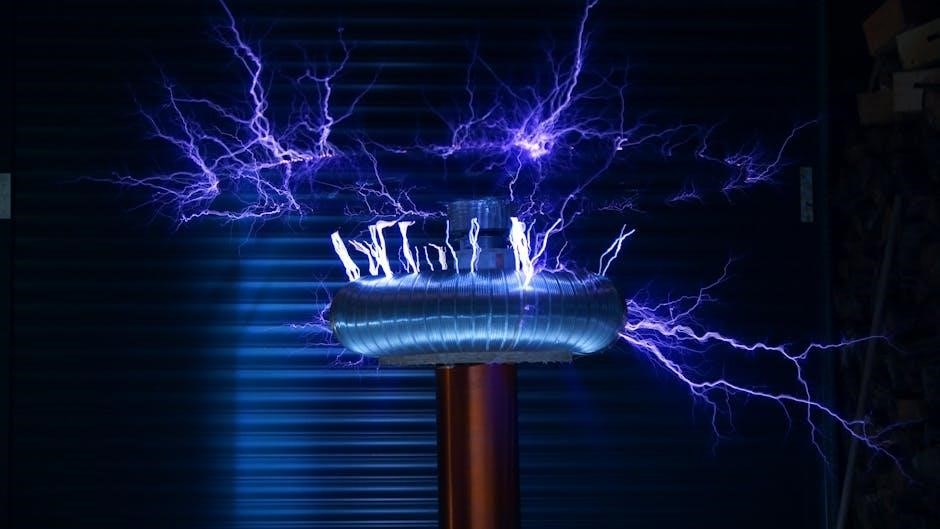The 2017 National Electrical Code (NEC) is a comprehensive document produced by the National Fire Protection Association (NFPA), outlining safety standards for electrical installations. Adopted by various jurisdictions, it ensures compliance with modern electrical practices, providing guidelines for safe and reliable systems. The NEC is widely recognized as the benchmark for electrical safety in the United States and is available as a free PDF for reference.
1.1 What is the NEC?
The National Electrical Code (NEC) is a model code that provides standardized requirements for the safe installation and operation of electrical wiring, equipment, and systems. Published by the National Fire Protection Association (NFPA), it serves as the foundation for electrical safety regulations across the United States. The NEC is not a federal law but is widely adopted by state and local jurisdictions to ensure compliance with electrical safety standards. It applies to public and private buildings, homes, outdoor installations, and utility equipment. The 2017 NEC edition includes updated guidelines to address emerging technologies and enhance safety practices. It is available as a free PDF download through official NFPA sources, making it accessible for electricians, contractors, and inspectors to ensure adherence to modern electrical practices.
1.2 Importance of the NEC in Electrical Safety
The National Electrical Code (NEC) plays a critical role in ensuring electrical safety by providing standardized guidelines for installations, preventing hazards, and protecting people and property from electrical risks. As a consensus-based code, it reflects expert input from various stakeholders, making it a trusted framework for safe practices. The NEC minimizes the risk of fires, shocks, and other electrical accidents by specifying requirements for wiring, equipment, and systems. Compliance with the NEC is enforced by local authorities, ensuring consistency and safety across residential, commercial, and industrial settings. Regular updates, such as the 2017 edition, address new technologies and emerging risks, maintaining its relevance and effectiveness in safeguarding lives and property.
1.3 Historical Background of the NEC
The National Electrical Code (NEC) traces its origins to 1897 when the first edition was published by the National Fire Protection Association (NFPA). Initially developed to address growing electrical hazards, the NEC evolved from voluntary guidelines to a mandatory code enforced by jurisdictions nationwide. Over the years, updates reflected technological advancements, such as the introduction of grounding requirements and arc fault protection. The 2017 edition continued this tradition, incorporating changes to address emerging technologies and safety concerns. This historical progression underscores the NEC’s role as a dynamic document adapting to electrical innovations while maintaining its core mission of safeguarding people and property from electrical dangers.

Key Changes in the 2017 NEC Edition
The 2017 NEC introduced significant updates to enhance electrical safety and adapt to new technologies. Changes included expanded requirements for arc fault protection, updated grounding and bonding rules, and new provisions for emerging technologies like energy storage systems. The code also introduced new articles addressing topics such as large-scale photovoltaic electric power systems and shared lighting controls. These revisions reflected the evolving electrical landscape, ensuring safer installations and addressing modern challenges in electrical design and operation. The updates were designed to align with advancements in technology while maintaining a focus on protecting people, property, and the environment from electrical hazards.
2.1 New Articles Introduced in the 2017 Edition
The 2017 National Electrical Code (NEC) introduced several new articles to address emerging technologies and safety concerns. Article 690.1 specifically addressed photovoltaic (PV) systems, providing detailed requirements for PV installations. Article 691 focused on large-scale PV systems, offering guidelines for utility-scale installations. Additionally, Article 710 was introduced to cover DC systems, ensuring proper installation and safety standards for direct current applications. Article 712 addressed stationary storage battery systems, emphasizing safety measures for energy storage technologies. Furthermore, Article 626 was added to regulate electric vehicle charging systems, ensuring safe and efficient charging infrastructure. These new articles reflected the growing demand for renewable energy, energy storage, and electric vehicle integration, aligning the NEC with modern electrical advancements and ensuring comprehensive safety standards for new technologies.
2;2 Updates to Existing Articles for Enhanced Safety
The 2017 NEC included significant updates to existing articles to enhance electrical safety. Article 210 was revised to expand arc fault protection requirements, reducing fire hazards in residential circuits. Article 250 was updated to clarify grounding and bonding requirements, ensuring safer electrical systems. Article 680 was modified to require ground-fault circuit interrupter (GFCI) protection for all swimming pool areas, improving safety around water. Additionally, Article 450 was updated to include new efficiency standards for transformers. These updates reflect advancements in technology and address potential hazards, ensuring the NEC remains a robust framework for electrical safety. The revisions emphasize proactive measures to prevent accidents and align with modern electrical practices.
2;3 Revisions to Address Emerging Technologies
The 2017 NEC introduced revisions to address emerging technologies, ensuring safety and adaptability. Article 691 was added to cover large-scale photovoltaic (PV) systems, providing guidelines for safe installation and maintenance. Article 694 was updated to include requirements for small-scale PV systems, enhancing safety for residential and small commercial applications; Additionally, Article 705 was revised to address interconnections between on-site power generation and the electrical grid, ensuring compatibility and safety. These updates reflect the growing adoption of renewable energy sources and smart technologies, aligning the NEC with modern advancements. By incorporating these changes, the NEC supports innovation while maintaining rigorous safety standards for electrical systems.

Safety Standards and Requirements
The 2017 NEC establishes essential safety standards, including arc fault protection, grounding and bonding, and GFCI requirements, to prevent electrical hazards and ensure safe installations.
3.1 Arc Fault Protection Requirements
The 2017 NEC mandates arc fault protection requirements to reduce electrical fire hazards. Arc Fault Circuit Interrupters (AFCIs) are now required in more areas, including kitchens, dining rooms, and bathrooms, to detect dangerous arcing conditions. These devices interrupt the circuit when an arc fault is detected, preventing fires. The code specifies that AFCIs must be installed in all new residential constructions and in existing homes during renovations. This requirement applies to 120-volt, single-phase, 15- and 20-ampere branch circuits. The updated standards ensure enhanced safety by addressing potential fire risks associated with faulty or damaged wiring. Compliance with these requirements is critical for protecting people and property from electrical fires.
3.2 Grounding and Bonding Requirements
The 2017 NEC emphasizes grounding and bonding as critical components of electrical safety. Grounding ensures equipment and conductors are at earth potential, preventing voltage differences that could cause shocks or equipment damage. Bonding requires connecting metal parts and systems to ensure electrical continuity and safety. Article 250 outlines specific requirements for grounding and bonding, including the use of grounding electrodes, bonding jumpers, and equipment grounding conductors. These measures are essential for protecting people and property from electrical hazards. Compliance with these standards ensures systems operate safely under various conditions, reducing the risk of electrical fires and shocks. Proper installation and inspection of grounding and bonding systems are mandatory to meet NEC standards.
3.3 GFCI Protection Requirements
The 2017 NEC mandates the use of Ground Fault Circuit Interrupters (GFCIs) in specific locations to protect against ground faults, which can cause severe electrical shocks. GFCIs are required in areas like kitchens, bathrooms, outdoor spaces, and garages, where moisture is present, increasing the risk of electrical hazards. The NEC specifies that GFCI protection must be installed in all 125-volt, single-phase, 15- and 20-ampere receptacles in these areas. Additionally, the 2017 edition expanded GFCI requirements to include 240-volt receptacles under certain conditions. Proper installation, testing, and maintenance of GFCI devices are essential to ensure they function correctly and provide continuous protection against ground faults. These requirements are outlined in Article 210 of the NEC, emphasizing electrical safety in residential and commercial settings.

Installation and Maintenance Guidelines
The 2017 NEC provides detailed guidelines for electrical installations, including conductor sizing, wiring methods, and material specifications. Proper maintenance ensures system safety and compliance with code standards.
4.1 General Installation Requirements
The 2017 NEC outlines essential installation requirements to ensure electrical systems are safe and reliable. These guidelines cover proper wiring methods, conductor sizing, and material specifications. Compliance with these standards is critical to prevent hazards and ensure adherence to local and national codes. The NEC emphasizes the importance of load calculations, voltage drop considerations, and proper grounding techniques. Additionally, it provides detailed instructions for installing electrical equipment, including circuit breakers, fuses, and outlets. The code also addresses the use of approved materials and equipment ratings to withstand operational demands. Proper permits and inspections are required to verify compliance, ensuring installations meet safety and performance standards. Regular maintenance is recommended to uphold system integrity and prevent potential failures.
4.2 Conductor Sizing and Ampacity
The 2017 NEC provides detailed guidelines for conductor sizing and ampacity to ensure safe and efficient electrical systems. Proper conductor sizing is critical to handle the maximum current loads without overheating, which can lead to fires or equipment damage. The NEC includes tables that specify the ampacity of conductors based on their size, material, and operating temperature. These tables help electricians determine the appropriate wire size for specific applications, considering factors like voltage drop and ambient temperature. Additionally, the code addresses the importance of derating conductors when multiple wires are bundled together, as this can reduce their overall ampacity. Compliance with these requirements ensures reliable performance and minimizes the risk of electrical hazards. Regular updates in the NEC reflect advancements in materials and installation practices, providing a safer framework for electrical systems.
4;3 Wiring Methods and Materials
The 2017 NEC outlines approved wiring methods and materials to ensure safe and durable electrical installations. Common wiring methods include the use of nonmetallic-sheathed cables (e.g., Romex®), metal-clad cables, and rigid metal conduits. Materials must be selected based on their suitability for the environment, such as moisture-resistant cables for outdoor or wet locations. The NEC specifies requirements for wire insulation, conductor types, and connectors to prevent hazards like arcing or overheating. Additionally, it addresses the use of flexible cords and cables, ensuring they are rated for their intended applications. Proper wiring methods and materials are essential for complying with safety standards and maintaining reliable electrical systems. The code also provides guidelines for securing wires and cables to prevent damage and ensure long-term performance. These requirements are critical for protecting people and property from electrical risks.

Equipment and Device Specifications
The 2017 NEC specifies requirements for electrical equipment and devices, ensuring safe operation and compatibility. Overload protection devices, surge protectors, and electrical panels must meet standardized ratings and installation criteria.
5.1 Overload Protection Devices
Overload protection devices are essential for safeguarding electrical systems from damage caused by excessive current. The 2017 NEC mandates the use of approved circuit breakers and fuses to interrupt circuits during overloads, ensuring safety and preventing potential fires. Proper sizing and installation of these devices are critical to match the system’s voltage and current ratings. The code emphasizes the importance of selecting devices that can handle the maximum expected load while adhering to specific interrupting capacity requirements. Regular maintenance and testing of overload protection devices are also recommended to ensure reliable operation. Compliance with these standards helps protect people and property from electrical hazards, aligning with the NEC’s primary goal of safety in electrical systems.
5.2 Electrical Panel Requirements
The 2017 NEC establishes specific requirements for electrical panels to ensure safe and efficient power distribution. Panels must be rated for the system’s voltage and current, with proper overcurrent protection devices installed. The code mandates clear labeling of all circuits and components for easy identification. Electrical panels must be installed in accessible locations, with adequate working space clearance to prevent hazards during maintenance. Additionally, panels must be grounded and bonded according to NEC standards to ensure electrical safety. The use of arc fault protection and surge-protective devices is also emphasized to mitigate potential risks. Compliance with these requirements helps prevent electrical fires, shocks, and other hazards, ensuring a safe and reliable electrical system. Proper installation and maintenance of panels are critical for long-term performance and safety.
5.3 Surge Protection Devices
The 2017 National Electrical Code (NEC) emphasizes the importance of surge protection devices (SPDs) to safeguard electrical systems from voltage spikes and transients. These devices are crucial for preventing damage to equipment and ensuring system reliability. According to the NEC, SPDs must be listed and labeled for their intended use, with ratings appropriate for the system’s voltage and surge requirements. Installation must comply with Article 285, which outlines specific requirements for SPDs, including their location, connection methods, and sizing. Proper grounding and bonding are essential for effective surge protection. The code also addresses the need for SPDs in various applications, such as service entrances and critical circuits, to enhance electrical safety and reduce the risk of costly damages. Compliance ensures systems remain protected against unpredictable power surges and transients.

Compliance and Inspection Process
Compliance with the 2017 NEC ensures electrical systems meet safety standards. The inspection process involves verifying installations against code requirements, with checklists guiding evaluators. Proper documentation and certification are mandatory to confirm adherence to NEC guidelines.
6.1 Permitting Requirements
Compliance with the 2017 NEC requires obtaining necessary permits before starting electrical work. Permits ensure that installations meet safety standards and are inspected by authorities. Electrical permits are typically mandatory for new installations, renovations, or significant repairs. Local jurisdictions may require additional documentation, such as detailed plans or blueprints, to issue permits. Fees for permits vary based on the scope and complexity of the project. Failure to obtain the proper permits can result in fines, legal consequences, or even the need to redo the work. Inspections are conducted to verify compliance with NEC guidelines, and approval is required before finalizing the project. Adhering to permitting requirements ensures safety and avoids potential legal issues.
6.2 Inspection Process and Checklists
The 2017 NEC mandates a thorough inspection process to ensure compliance with electrical safety standards. Inspections are conducted by authorized personnel, typically local electrical inspectors, to verify that installations meet NEC requirements. A structured checklist is often used to systematically evaluate components such as wiring, grounding, and equipment installations. The process may include preliminary inspections during initial stages, rough-in inspections before final connections, and final inspections upon completion. Any deviations from the code must be corrected before approval. Checklists help ensure consistency and accuracy, covering aspects like proper conductor sizing, GFCI installation, and arc fault protection. Compliance with these procedures ensures safety and avoids potential hazards, making inspections a critical step in the electrical installation process.
6.3 Certification and Documentation
Certification and documentation are critical for ensuring compliance with the 2017 NEC. Electrical installations must be certified by authorized personnel, confirming adherence to safety standards. Proper documentation, including permits, inspection reports, and test results, is essential for verification. Records must be maintained to demonstrate compliance during inspections and audits. The NEC emphasizes the importance of accurate and complete documentation to avoid legal issues and ensure safety. Certification ensures that electrical systems are installed correctly, while documentation provides a trail for future reference and accountability. Both processes are integral to upholding the code’s standards and protecting people and property from electrical hazards.

Enforcement and Legal Aspects
The NEC is enforced by local, state, and federal authorities to ensure compliance with electrical safety standards. Legal penalties for violations include fines and potential lawsuits, emphasizing the importance of adherence to the code to protect lives and property.
7.1 Enforcement of NEC by Authorities
The enforcement of the National Electrical Code (NEC) is carried out by local, state, and federal authorities to ensure electrical installations meet safety standards. These authorities conduct regular inspections of electrical systems to verify compliance with the NEC. Permits are required for most electrical work, and inspections are typically mandatory before final approval. Certificates of occupancy are issued only after compliance is confirmed. Authorities also handle violations, which can lead to penalties such as fines or work stoppages. The NEC is adopted into law by jurisdictions, making it enforceable through legal frameworks. Proper documentation and adherence to the code are critical to avoid legal consequences. Article 80 of the NEC specifically addresses the enforcement and jurisdictional requirements, ensuring uniform application of the code. This process safeguards public safety and prevents potential hazards.
7.2 Penalties for Non-Compliance
Non-compliance with the National Electrical Code (NEC) can result in significant penalties, including fines, legal action, and project delays. Authorities enforce these penalties to ensure adherence to safety standards. Violations may lead to work stoppages until corrections are made. In severe cases, penalties include criminal charges for negligence. Repeat offenses can result in escalated fines and loss of licensing for contractors. Additionally, property owners may face legal repercussions if non-compliant electrical systems cause accidents or damage. Penalties emphasize the importance of following NEC guidelines to protect people and property from electrical hazards. Proper documentation and inspections are critical to avoid these consequences. Compliance ensures safety and avoids financial and legal risks associated with violations.
7.3 Legal Cases Involving NEC Violations
Legal cases involving NEC violations often arise from non-compliance leading to accidents or property damage. Courts use the NEC as a standard to determine negligence. For instance, if an electrical fire caused by improper wiring results in injuries, the responsible party may face lawsuits. Judges rely on NEC guidelines to assess whether safety protocols were followed. Violations can lead to significant financial penalties and liability for damages. In some cases, contractors or property owners may be held criminally liable for severe negligence. These legal actions highlight the importance of adhering to NEC standards to avoid legal consequences. Such cases serve as precedents, reinforcing the necessity of compliance and proper documentation in electrical work. They also underscore the role of inspections and certifications in preventing violations and ensuring accountability.

Training and Resources
The 2017 NEC offers extensive training programs, including online courses and workshops, to help electricians and DIYers understand and apply the code effectively. Resources like the NEC Handbook and reference guides provide detailed explanations and practical examples, ensuring compliance with safety standards and code updates. These materials are essential for staying informed and proficient in electrical installations and safety practices.
8.1 Training Programs for Electricians
Training programs for electricians based on the 2017 National Electrical Code (NEC) are designed to enhance understanding and compliance with the latest safety standards. These programs, offered by organizations like NTT and NFPA, include comprehensive courses, workshops, and apprenticeships. They cover key topics such as conductor sizing, grounding requirements, and arc fault protection. Online platforms provide flexible learning options, while hands-on training ensures practical application of code principles. Many programs also focus on exam preparation for licensing and certification. By participating in these programs, electricians can stay updated on the NEC and ensure safe, efficient electrical installations. These resources are essential for both new professionals and experienced electricians seeking to maintain compliance with the evolving standards of the electrical industry.
8.2 Reference Materials and Guides
Reference materials and guides for the 2017 National Electrical Code (NEC) are essential tools for electricians and professionals seeking to understand and apply the code effectively. The NFPA 70 Handbook provides detailed explanations, illustrations, and examples to clarify complex requirements. Additional resources include the National Electrical Code Handbook, which offers practical insights and real-world applications. Online guides and publications, such as those from McGraw-Hill, provide updated standards and interpretations. These materials are designed to assist in navigating the code’s articles, including grounding and bonding, arc fault protection, and conductor sizing. By utilizing these references, professionals can ensure compliance and improve their understanding of electrical safety practices. These resources are indispensable for maintaining up-to-date knowledge and adhering to the NEC’s guidelines.
8.3 Online Resources and Tools

Online resources and tools for the 2017 National Electrical Code (NEC) provide convenient access to code information and training. The NFPA website offers free access to the NEC through their online platform, allowing users to view the code electronically. Additionally, PDF versions of the NEC are available for download, enabling offline reference. Online training programs, such as those offered by McGraw-Hill, provide interactive learning experiences and exam preparation materials. Webinars and e-learning modules are also available, covering topics like code updates and safety standards. These resources are complemented by online forums and communities where professionals can discuss challenges and share insights. Such tools enhance understanding and compliance with the NEC, ensuring electrical safety in various installations and projects.

Future of the NEC and Emerging Trends
The NEC is continuously updated to address emerging technologies and safety needs. Future editions will focus on integrating renewable energy, electric vehicles, and smart grid systems, ensuring safer and more efficient electrical installations.
9.1 Upcoming Changes in Future Editions
Future editions of the NEC are expected to incorporate new technologies and address evolving safety concerns. One major focus will be on renewable energy systems, including expanded requirements for solar and wind installations. Electric vehicle charging infrastructure will also see updated standards to accommodate growing demand. Additionally, the NEC will likely introduce more stringent requirements for arc fault and ground fault protection to enhance safety in both residential and commercial settings. The integration of smart grid technologies and energy storage systems is another area anticipated to receive significant updates. These changes aim to ensure the NEC remains a leader in electrical safety, adapting to technological advancements while protecting people and property from hazards. By staying proactive, the NEC will continue to set the standard for safe and efficient electrical installations.
9.2 Impact of New Technologies
New technologies are reshaping the electrical landscape, prompting updates to the NEC to ensure safety and compatibility. Advances in renewable energy systems, such as solar and storage, require revised installation and safety standards. Smart grid technologies and energy-efficient devices are driving changes in wiring and power distribution. The rise of electric vehicles (EVs) has led to new charging station requirements. Additionally, emerging technologies like arc fault protection devices and ground fault circuit interrupters (GFCIs) are enhancing safety protocols. These advancements necessitate regular updates to the NEC to address potential hazards and ensure reliable integration. By adapting to technological progress, the NEC maintains its role as a cornerstone of electrical safety, protecting people and property while supporting innovation. These updates reflect the dynamic nature of the electrical industry and its commitment to safety and efficiency.
9.3 Role of the NEC in Smart Electrical Systems
The NEC plays a pivotal role in shaping the framework for smart electrical systems by providing standardized guidelines for their safe and efficient integration. As technology advances, the NEC ensures that smart devices, renewable energy systems, and automated controls comply with safety protocols. It addresses the installation and operation of smart meters, energy management systems, and grid-connected devices, ensuring minimal risks. The NEC also supports the scalability of smart systems, allowing for future innovations while maintaining reliability. By harmonizing cutting-edge technologies with established safety standards, the NEC facilitates the adoption of smart electrical systems across residential, commercial, and industrial sectors, fostering a safer and more interconnected electrical infrastructure.

